Contents
- 1. users manual 1
- 2. users manual 2
- 3. users manual 3
- 4. users manual 4
users manual 2
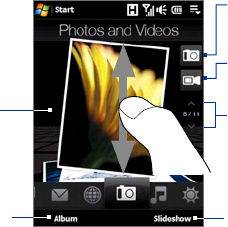
TouchFLO™ 3D 67
Photos and Videos
The Photos and Videos tab lets you visually flip through your photos and
video clips and view them in full screen. From this tab, you can also activate
the Camera so you can take pictures and record video clips.
The Photos and Videos tab displays pictures and video files from the
current favourite album. By default, the Camera Shots album which stores
the pictures and videos that you captured using the device camera is set as
the favourite. You can change to another favourite album, if preferred.
To set an album as a Favourite
1. On the Photos and Videos tab, touch Album to open the Album
program.
2. Touch Albums and then select one of the listed favourite albums.
3. Tap Menu > Set as Favourite. and then tap OK on the confirmation
screen.
To view photos and videos
Touch the photo or
video on the screen
to view or play it in
full screen.
Touch here to open
the Album program.
(See “Viewing Photos
and Videos Using
Album” in Chapter 11
for details.)
Touch here to take a
photo.
Touch Slideshow to
view the photos as a
slideshow. If a video is
selected, touch Play.
To flip through photos and
videos, swipe upward/
downward, touch the
Up/Down arrow, or press
Navigation Up/Down.
Touch here to shoot
video.
Tips • For more information about viewing in full screen, see “View an image”
and “Play back video” in Chapter 11. The file formats that can be viewed on
the Photos and Videos tab are the same as the Album program.
• To transfer media files from a computer and view them on the Photos
and Videos tab, copy or synchronize them to a folder under \My Device
(the device memory) or \Internal Storage (the built-in storage).
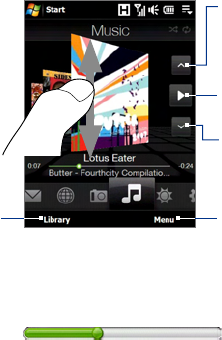
68 TouchFLO™ 3D
Music
The Music tab allows you to visually browse through albums and music
tracks and play music. The albums and music tracks that you see on the
Music tab are from the Now Playing list of the Library.
Note Your device searches for all music files that have the following audio formats:
MP3 (.mp3), WMA (.wma), AAC/AAC+ (.aac), and MPEG-4 (.m4a). It searches
for music from the following locations:
Device: \My Music (including all subfolders)
\My Documents (including all subfolders)
Storage: \Internal Storage (including all subfolders)
To play music
On the Music tab, flip through albums and all the music in each album,
then touch the Play icon on the middle-right side of the screen to start
playback.
Touch here to go to the
previous album or the
previous music in the
current album.
Swipe upward/
downward on the
screen or press
Navigation Up/Down
to flip through
albums and the music
or songs in an album.
Touch here to play or pause.
You can also press the ENTER
button to play or pause.
Touch here to go to the next
album or the next music in
the current album.
Touch Menu to set music
playback to Repeat, turn
Shuffle on or off, and more.
Touch here to
access the Library.
To advance forward or backward in the music
Do one of the following:
Touch and hold on the thin bar below the album art to display the
progress bar:
Drag your finger right or left on the progress bar to move forward or
backward in the current music.
Slide your finger around the Navigation Control as follows:
•
•
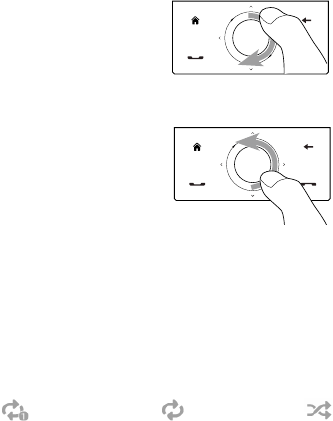
TouchFLO™ 3D 69
Slide your finger clockwise to
advance forward in the music.
To move backward in the music,
slide your finger counterclockwise.
To set repeat and shuffle modes
Touch Menu > Repeat and choose whether to repeat once, repeat all, or do
not repeat. To toggle shuffle mode on and off, touch Menu > Shuffle and
then select Shuffle On or Shuffle Off.
The icons on the upper-right side of the Music tab show whether repeat
and shuffle modes are enabled.
Repeat [One] Repeat [All] Shuffle [On]
To browse and play music in the Library
The Library organizes music into categories, such as Now Playing, Artists,
Albums, Genres, All Songs, and more. When you add more albums or
music tracks to your device, go to the Library to locate and play the new
albums or music tracks.
On the Music tab, touch Library to open the Library screen.
The tabs at the bottom of the Library screen correspond to the
different categories. To browse music under a certain category, slide
to the tab that corresponds to the desired category.
Tap a music track to play it.
Note When you select a category in the Library such as Artists and play its
music, the Now Playing list will be replaced with the music tracks from that
category.
1.
2.
3.

70 TouchFLO™ 3D
To use playlists
You can group your favourite music into a playlist and then play back the
playlist.
To create a new playlist:
Select the desired music on the Music tab or the Library.
Touch Menu > Add to Playlist.
Touch <New Playlist>, enter a Playlist name and then touch OK.
To add more music files to a playlist:
On the Playlists tab, touch a playlist to open it.
Touch Menu > Edit.
Touch Menu > Add.
Select the check boxes of the music you want to add to the
playlist, or touch Menu > Select All to choose all the music.
Touch OK three times and then touch Up to return to the Playlists
tab.
To play back a playlist:
On the Playlists tab, touch a playlist to open it.
Touch the first song in the playlist. The Music tab starts playing
the first song. After each song, the next one in the playlist will be
played.
Note Playlists are not automatically updated when music files have been
deleted from the device memory or internal storage.
There are two types of playlists that can be shown on the Playlists tab:
Custom playlists. Playlists that are created on the Music tab.
Windows Media® Player playlists. Playlists that are in Windows
Media® Player Mobile’s Library (which is synchronized with Windows
Media® Player on your computer). They are indicated by the Windows
Media® Player icon ( ). These playlists cannot be edited.
•
1.
2.
3.
•
1.
2.
3.
4.
5.
•
1.
2.
•
•
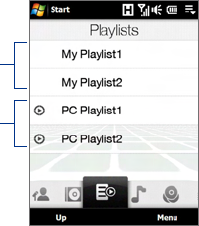
TouchFLO™ 3D 71
Custom playlists
Windows Media®
Player playlists
Note If a Windows Media® Player playlist contains a combination of music, video
and image files, only music files in the playlist will be synchronized to your
device and other media types will be filtered out.
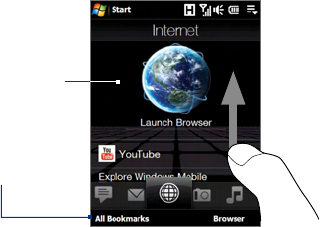
72 TouchFLO™ 3D
Internet
On the Internet tab, you can open Opera Mobile™ to browse the web and
add web favourites for one-touch access to your favourite web sites.
Touch here to browse the
web using Opera Mobile.
Touch All Bookmarks to
open Opera Mobile and
Swipe upward or press
Navigation Down to
scroll down the screen
and access more web
favourites.
For more information about using Opera Mobile, see Chapter 8.
Weather
The Weather tab shows you the current weather as well as weather
information for the next five days of the week.
To add a city
The Weather tab can display weather information of your local city and
other added cities. Follow the steps below to add a city on this tab.
Tip You can add up to 10 cities on the Weather tab.
On the Weather tab, touch Menu > Add Location.
The Select Country screen then appears. Flick your finger on the
screen repeatedly in light, quick strokes to continuously scroll down
the list of countries. You can also slowly scroll through the country
list by dragging your finger upward on the screen. Touch the desired
country to select it.
The Select City screen then appears. Flick your finger on the screen
repeatedly in light, quick strokes to continuously scroll down the list
of cities. You can also slowly scroll through the city list by dragging
your finger upward on the screen. Touch the desired city to select it.
1.
2.
3.
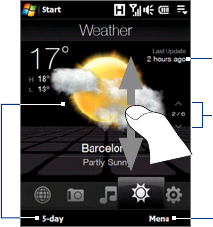
TouchFLO™ 3D 73
To view weather information
Your device automatically connects to the Internet via the 3G/GPRS/EDGE
data connection or Wi-Fi to download and display weather information. The
current temperature, temperature range, type of weather (sunny, cloudy,
showers, or others), and the time of day (daytime or nighttime) are shown
on the Weather tab. To see the weather information for the next five days
of the week, touch the screen or touch 5-day at the bottom-left side of the
screen.
Touch the screen or
touch 5-day at the
bottom to see the
weather information
for the next five days
of the week. Touch Menu to add or
delete a city, change the
temperature to Celsius
or Fahrenheit, and more.
Shows the last weather
update. Touch this item
to download the latest
weather information.
To switch between
cities, swipe your finger
upward/downward, touch
the Up/Down arrow
on the screen, or press
Navigation Up/Down.
To choose download options
1. On the Weather tab, touch Menu > Settings.
Tip You can also slide to the Settings tab and then touch Data.
2. You can choose from the following options:
Download weather automatically. When this option is selected,
weather information is automatically downloaded from the
AccuWeather web site whenever you select the Weather tab, if the
data has not been updated within the last three hours. Weather
data is also downloaded every time an ActiveSync connection is
established (through over-the-air or USB connections).
Clear this option if you prefer to manually download weather
information.
•
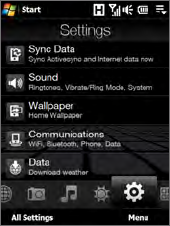
74 TouchFLO™ 3D
Download weather when roaming. Select this option only if
you want to allow automatic download of weather data when
roaming. This may incur additional costs.
Settings
The Settings tab allows you to synchronize information with your
computer or the Exchange Server, change sound settings such as the ring
tone, and choose a different wallpaper for the Home tab. You can also easily
turn on and off the communications features of your device such as Wi-Fi,
Bluetooth, and more.
•
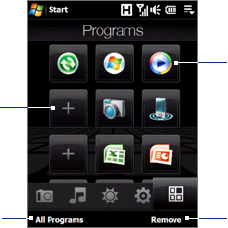
TouchFLO™ 3D 75
Programs
The Programs tab allows you to add your favourite programs for one-touch
access.
Touch a program
icon to open the
corresponding
program.
Touch Remove to
choose which program
to remove from the
Programs tab.
Touch an
empty slot to
Touch All Programs
to access all the
programs of your
device.
When you have filled up the screen with programs, scroll down the
Programs tab to access more empty slots and add more programs. To scroll
down, press and hold on the screen and then drag your finger upward. You
can add up to 18 favourite programs.
To scroll back up, press and hold on the screen and then drag your finger
downward.
Note To replace a slot with another program, you must delete the occupying
program shortcut first and then add your desired program.
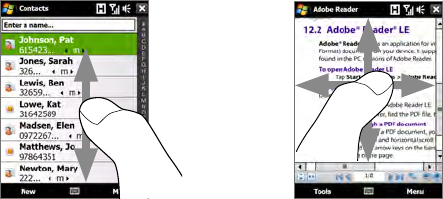
76 TouchFLO™ 3D
3.3 Finger Gestures
You can use finger gestures to scroll, zoom and pan on the touch screen.
Finger scrolling
Finger scrolling can be used to scroll up and down web pages, documents,
and lists such as the contacts list, file list, message list, calendar
appointments list, and more.
When finger
scrolling, swipe or
flick your finger on
the touch screen.
To scroll up and down
To scroll down, swipe your finger upward on the touch screen.
To scroll up, swipe your finger downward on the touch screen.
To auto-scroll, flick your finger upward or downward on the touch
screen. Touch the screen to stop scrolling.
To scroll left and right
To scroll towards the right, swipe your finger to the left.
To scroll towards the left, swipe your finger to the right.
To auto-scroll, flick your finger left or right. Touch the screen to stop
scrolling.
•
•
•
•

TouchFLO™ 3D 77
Finger zooming
The type of finger gesture to use when zooming varies in different
programs.
To zoom in on a web page in Opera Mobile, tap your finger twice on
the screen. See “Using Opera Mobile” in Chapter 8 for details.
To zoom in on a photo in Album, make a full-circle swipe on the touch
screen. See “Viewing Photos and Videos Using Album” in Chapter 11
for details.
Finger panning
You can use finger panning to move to and
view other parts of a zoomed photo, web
page, document, or an e-mail. To pan, touch
and hold on the touch screen and then drag
your finger in any direction.
Tip To enable or mute finger scrolling and
panning sound, touch Start > Settings >
System tab > TouchFLO, and then select
or clear the Enable sound when finger
scrolling and panning check box.
•
•
78 TouchFLO™ 3D
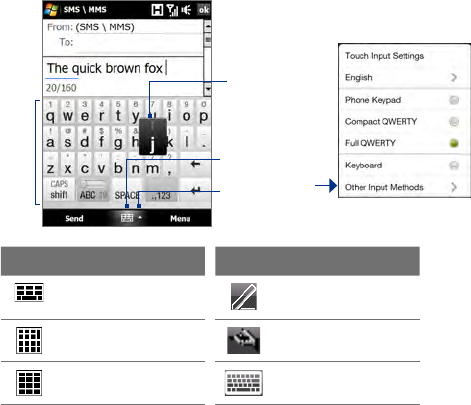
80 Entering Text
4.1 Selecting an Input Method
When you start a program or select a field that requires text or numbers, the
Input Panel icon becomes available on the menu bar.
Tap the Input Selector arrow (that appears next to the Input Panel icon)
to open a menu where you can select a text input method and customize
input options. After selecting a text input method, the corresponding Input
Panel is displayed, which you can use to enter text.
Tip Select Other Input Methods to display more input methods.
To show or hide the Input Panel, tap the Input Panel icon.
Input Panel
(Full QWERTY)
Input Selector
arrow
Input Panel icon
Text input methods
Key when
pressed
Icon Input method Icon Input method
Full QWERTY Letter Recognizer or
Block Recognizer
Compact QWERTY Transcriber
Phone Keypad Keyboard
Notes • Some text input methods may not be available in certain language
versions of the device.
• When in landscape mode, the Compact QWERTY and Phone Keypad are
not available.
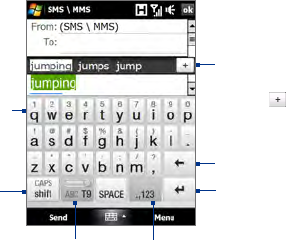
Entering Text 81
4.2 Using the Full QWERTY
The Full QWERTY is a full on-screen QWERTY keyboard layout similar to a
desktop PC keyboard.
Tip You can also use the Windows Mobile on-screen keyboard which also has a
QWERTY keyboard layout by selecting Keyboard (or Other Input Methods
> Keyboard) on the Text input method menu.
• Tap to enter letters
or symbols.
• Tap and hold
to enter a
punctuation mark,
symbol, or number
that appears on
top of a key
• Tap to enter an
uppercase letter.
• Tap twice to turn
on Caps Lock.
Tap to toggle between using Normal
or T9 mode.
Tap to open a keyboard layout
that lets you easily enter numbers
and symbols. See “Using Numeric
and Symbol Mode” for details.
Tap to create a
new line.
Tap to delete the
previous character.
Displays the word
candidate list in T9
mode. Tap a word
to insert it into your
text. Tap to add
a word to the T9
dictionary.
To enter text using the Full QWERTY
1. Start a program that accepts text input, such as Word Mobile.
2. Tap the Input Selector arrow, then tap Full QWERTY.
3. Start tapping keys on the keyboard as you would on a PC keyboard to
enter your text. To learn how to enter text using T9 mode, see “Using
Multitap and T9 Modes” in this chapter.
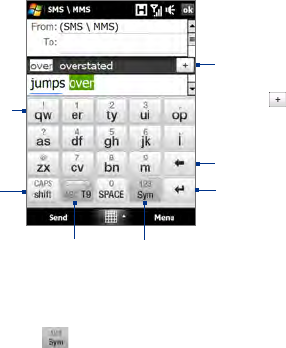
82 Entering Text
4.3 Using the Compact QWERTY
The Compact QWERTY is a type of on-screen keyboard which features 20
keys. With its large, touch-friendly keys and enhanced features such as T9
predictive input, you can enter text faster and more accurately.
• Tap to enter letters
or symbols.
• Tap and hold
to enter a
punctuation mark,
symbol, or number
that appears on
top of a key
• Tap to enter an
uppercase letter.
• Tap twice to turn
on Caps Lock.
Tap to toggle between using
Multitap or T9 mode.
Tap to create a
new line.
Tap to delete the
previous character.
Displays the word
candidate list in T9
mode. Tap a word
to insert it into your
text. Tap to add
a word to the T9
dictionary.
Tap to open a keyboard layout
that lets you easily enter numbers
and symbols. See “Using Numeric
and Symbol Mode” for details.
Tip You can tap and hold to immediately open the numeric keyboard.
To enter text using the Compact QWERTY
1. Start a program that accepts text input, such as Word Mobile.
2. Tap the Input Selector arrow, then tap Compact QWERTY.
3. Start tapping keys on the keyboard to enter your text. To learn how
to enter text using Multitap or T9 mode, see “Using Multitap and T9
Modes” in this chapter.
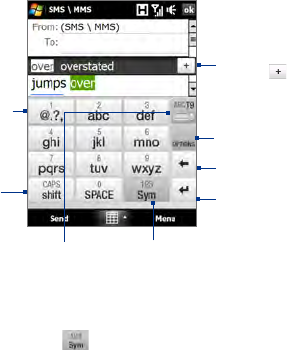
Entering Text 83
4.4 Using the Phone Keypad
The Phone Keypad is a 12-key on-screen keypad that has a layout similar to
mobile phone keypads, plus some additional keys. The Phone Keypad has
large keys and enhanced input features such as T9 predictive input, which
makes it faster for you to enter text in your messages and documents.
Tap to open a keyboard layout
that lets you easily enter numbers
and symbols. See “Using Numeric
and Symbol Mode” for details.
• Tap to enter letters
or symbols.
• Tap and hold
to enter a
punctuation mark,
symbol, or number
that appears on
top of a key
• Tap to enter an
uppercase letter.
• Tap twice to turn
on Caps Lock.
Tap to toggle between using
Multitap or T9 mode.
Tap to create a
new line.
Tap to delete the
previous character.
Displays the word
candidate list in T9
mode. Tap a word
to insert it into your
text. Tap to add
a word to the T9
dictionary.
Tap to open the
input settings.
Tip You can tap and hold to immediately open the numeric keyboard.
To enter text using the Phone Keypad
1. Start a program that accepts text input, such as Word Mobile.
2. Tap the Input Selector arrow, then tap Phone Keypad.
3. Start tapping keys on the keyboard to enter your text. To learn how
to enter text using Multitap or T9 mode, see “Using Multitap and T9
Modes” in this chapter.
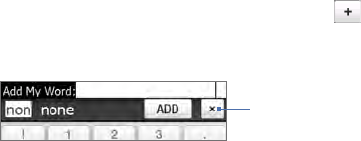
84 Entering Text
4.5 Using Multitap and T9 Modes
When using the on-screen keyboards, you can choose to enter text using
Multitap or T9 mode.
Multitap mode
In Multitap mode (for Compact QWERTY and Phone Keypad), enter a
character by tapping a key until the desired character is displayed on the
screen.
• To enter the first letter that shows on a key, tap the key once. To enter
the second letter, tap twice.
• To enter a punctuation mark, symbol, or number that appears on top
of a key, tap and hold the key.
T9 mode
T9 is a predictive text input mode which displays a word candidate list as
you enter the first few characters so you just select the word that you want.
To enter text using T9 mode
1. Start entering the first few letters of a word. As you enter each letter,
predicted words will appear above the keyboard.
2. Tap the desired word to immediately insert it to your text.
Note Navigate through the word candidate list if there are more words to
choose from.
To add a word to the T9 dictionary
If the word that you have entered is not found in the dictionary, you can
add it to the dictionary.
1. While in T9 mode, type a letter and then tap on right side of the
word candidate list.
2. Type the word you want to add and then tap ADD.
Tap to not add the word.
Entering Text 85
To customize Touch Input settings
1. Tap the Input Selector arrow, then tap Touch Input Settings.
2. On the Touch Input Settings screen, select or clear the following
options according to your preferences:
• Spell Correction. Lets you correct typographical errors by
selecting from a list of possible words that reflect the characters of
the keys you have tapped as well as characters of nearby keys.
• Word Completion in T9 mode. Lets you select from a list of
possible words based on the keys that you have tapped and on
the words available in the dictionary.
• Word Completion in ABC mode. Lets you select from a list of
possible combinations based on the characters that appear on the
keys that you tapped.
• Auto-Substitution. Automatically inserts an apostrophe
when you type common contracted words (for example, “dont”
automatically becomes “don’t”).
3. Tap Done.
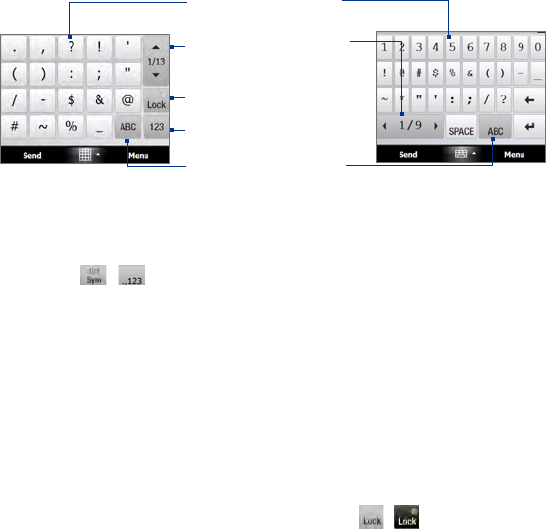
86 Entering Text
4.6 Using Numeric and Symbol Mode
Switch to Numeric and Symbol mode to let you easily enter numbers and
common symbols such as parentheses, braces, currency signs, punctuation
marks, special characters, and more. Numeric and Symbol mode is available
when using the Full QWERTY, Compact QWERTY, and Phone Keypad.
Tap a number or symbol
to insert it into your text.
Tap to go to the previous
or next page of symbols.
Tap to switch back to the
letter keyboard layout.
Tap to switch to the
numeric keyboard
See “To lock the keyboard in
Numeric and Symbol mode.”
Compact QWERTY and
Phone Keypad
Full QWERTY
To switch to Numeric and Symbol mode
1. While using Full QWERTY, Compact QWERTY, or Phone Keypad, tap
/ .
2. Locate the number or symbol, then tap it to insert it into your text.
To lock the keyboard in Numeric and Symbol mode
You can lock the keyboard in Numeric and Symbol mode so you can
continuously enter symbols and numbers.
1. Tap the Input Selector arrow and then tap Other Input Methods >
Options.
2. In the Input Method tab, select a Touch input method in the Input
method list, then tap Options.
3. Clear the Turn on one-touch symbol entry check box.
Tip In Compact QWERTY and Phone Keypad, tap / to toggle between
locking the keyboard in Numeric and Symbol mode and switching back to
the letter keyboard layout after tapping a symbol or number.
Entering Text 87
4.7 Using Block Recognizer
With Block Recognizer, you use a single stroke to write letters, numbers,
symbols, and punctuation, which are then converted into typed text.
To use Block Recognizer
1. From a program, tap the Input Selector arrow and then tap Other
Input Methods > Block Recognizer.
2. Write characters, numbers, and symbols in the designated writing
area.
• Enter letters by writing in the abc (left) area of the box.
• Enter numbers by writing in the 123 (right) area of the box.
• Enter symbols and punctuation by tapping the left or right area of
the box (a gray dot appears), then writing the desired character.
Tip For help with writing characters, tap the question mark near the writing area.
4.8 Using Letter Recognizer
With Letter Recognizer, you can write individual letters, numbers, and
punctuation marks, which are then converted into typed text.
To use Letter Recognizer
1. From a program, tap the Input Selector arrow and then tap Other
Input Methods > Letter Recognizer.
2. Write characters, numbers, and symbols in the designated writing
area.
• Enter uppercase letters by writing in the ABC (left) area of the box.
• Enter lowercase letters by writing in the abc (middle) area of the box.
• Enter numbers by writing in the 123 (right) area of the box.
• Enter punctuation and symbols by writing the desired character in
the 123 (right) area of the box.
Tip For help with writing characters, tap the question mark near the writing area.

88 Entering Text
4.9 Using Transcriber
Transcriber is a handwriting recognition program that enables you to write
in cursive, print, or a combination of both.
To write using Transcriber
1. Open a program that accepts user input, such as Word Mobile.
2. Tap the Input Selector arrow and then tap Other Input Methods >
Transcriber. The Transcriber introductory screen appears. Read the
introduction and tap OK.
3. Position the cursor where you want text to appear.
4. Use the stylus to write anywhere on the screen. The handwriting will
be converted to text shortly after you lift the stylus from the screen.
To enter punctuation and symbols
Transcriber comes with an on-screen keyboard that provides an easy way to
add punctuation or a special symbol to existing text. To use this on-screen
keyboard, tap on the Transcriber toolbar.
The keyboard remains visible until you tap the button again.
Tips • To reposition the keyboard, tap and hold the title bar, then drag to the
desired location.
• When no text is selected, you can open the keyboard by using the
gesture (draw a line straight down and then straight up). For more
information about using Transcriber gestures, see Help on your device.
To edit text
1. In a program, draw a line from left to right across the text you want to edit.
2. After you lift the stylus from the screen, the line disappears and the
selected text will be highlighted.
3. Do either of the following:
• Rewrite the text.
• Use gestures to capitalize letters, insert a space, and so on. For
information about using Transcriber gestures, see Help on your
device.
90 Synchronizing Information With Your Computer
5.1 About Synchronization
You can take information from your computer wherever you go by
synchronizing them to your device. The following types of information can
be synchronized between your computer and your device:
• Microsoft® Office Outlook® information, which include Office
Outlook e-mail, contacts, calendar, tasks, and notes
• Notes, which are created using Microsoft® Office OneNote® 2007
• Media, such as pictures, music, and video
• Favourites, which are the bookmarked links to your favourite web
sites
• Files, such as documents and other files
Before you can synchronize, you need to install and set up first the
synchronization software on your computer. For more information, see
“Setting Up Windows Mobile Device Center on Windows Vista®” and “Setting
Up ActiveSync® on Windows XP®” in this chapter.
Ways to synchronize
After you have installed the synchronization software on your computer,
connect and synchronize your device with your computer by:
• Using the supplied USB sync cable.
Upon connecting the sync cable to your device and your computer,
the synchronization process automatically starts.
• Using Bluetooth.
You must first set up a Bluetooth partnership between your device
and your computer before you can synchronize information
between them using Bluetooth. For more information about setting
up a Bluetooth partnership, see Chapter 9. For information about
synchronizing through Bluetooth, see “Synchronizing via Bluetooth”
later in this chapter.
Try to synchronize regularly in order to keep information up-to-date in both
your device and your computer.
Note You can also synchronize Outlook e-mail, contacts, calendar, and tasks on
your device with the Exchange Server at your work. For more information
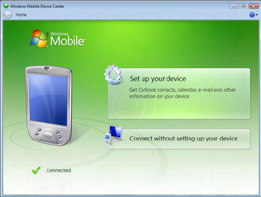
Synchronizing Information With Your Computer 91
about setting up your device to synchronize with the Exchange Server, see
Chapter 7.
5.2 Setting Up Windows Mobile® Device Center on
Windows Vista®
Microsoft Windows Mobile® Device Center is the replacement for
Microsoft® ActiveSync® on Windows Vista®.
Note Some versions of Windows Vista® come with Windows Mobile Device Center
already installed. If Windows Mobile Device Center is not available on your
Windows Vista®, you can install it from the Getting Started Disc that came
with your device.
Set up synchronization in Windows Mobile Device Center
When you connect your device to your computer and start Windows Mobile
Device Center for the first time, you are asked to create a Windows Mobile
partnership with your device. To create a partnership:
1. Connect your device to your computer. Windows Mobile Device
Center configures itself, then opens.
2. On the license agreement screen, click Accept.
3. On the Windows Mobile
Device Center’s Home
screen, click Set up your
device.
Note Choose Connect
without setting up
your device if you only
want to transfer media
files, check for updates,
and explore your device
but not synchronize
Outlook information.
4. Select the items you want to synchronize, then click Next.
5. Enter a device name, then click Set Up.
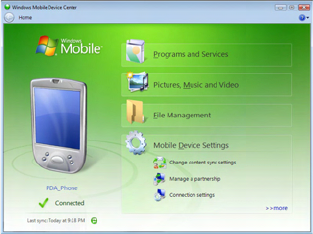
92 Synchronizing Information With Your Computer
When you finish the setup wizard, Windows Mobile Device Center
synchronizes your device automatically. Notice that Outlook e-mails and
other information appear on your device after synchronization.
Use Windows Mobile Device Center
To open Windows Mobile Device Center, click Start > All Programs >
Windows Mobile Device Center on your Windows Vista computer.
On Windows Mobile Device Center, you can do the following:
• Click Mobile Device Settings to change synchronization settings.
• When you click Pictures, Music and Video > XX new pictures/
video clips are available for import, a wizard guides you to tag
and transfer photos from your device to the Photo Gallery on your
computer.
• Click Pictures, Music and Video > Add media to your device from
Windows Media Player to synchronize music and video files using
Windows Media® Player. For more information, see “Using Windows
Media® Player Mobile” in Chapter 11.
• Click File Management > Browse the contents of your device to
view documents and files on your device.
Note See Windows Mobile Device Center Help for more information.
Synchronizing Information With Your Computer 93
5.3 Setting Up ActiveSync® on Windows XP®
The Getting Started disc that comes with your device contains Microsoft
ActiveSync 4.5 or later. Follow the steps in this section to install and set up
ActiveSync on Windows XP or other compatible Windows systems.
Note For a list of compatible Windows systems, go to
http://www.microsoft.com/windowsmobile/activesync/activesync45.mspx.
Install ActiveSync
1. Place the Getting Started disc to the disc drive of your computer.
2. Click Setup and Installation.
3. Select the ActiveSync check box, then click Install.
4. Read the license terms, then click Accept.
5. When installation is completed, click Done.
6. On the Getting Started with Windows Mobile screen, click Close.
Set up synchronization in ActiveSync
1. Connect your device to your computer. The Synchronization
Setup Wizard automatically starts and guides you to create a
synchronization partnership. Click Next to proceed.
2. To synchronize your device with your computer, clear the
Synchronize directly with a server running Microsoft Exchange
check box, then click Next.
3. Select the information types that you want to synchronize, then click
Next.
4. Select or clear the Allow wireless data connections check box
according to your preference.
5. Click Finish.
When you finish the wizard, ActiveSync synchronizes your device
automatically. Notice that Outlook e-mails and other information appear on
your device after synchronization.

94 Synchronizing Information With Your Computer
5.4 Synchronizing With Your Computer
Connect and synchronize your device with your computer using the USB
cable or Bluetooth connection.
Start and stop synchronization
You can manually synchronize either from your device or computer.
From your device
• On the TouchFLO 3D Home screen, slide to the Settings tab and then
touch Sync Data; or
• Tap Start > Programs > ActiveSync, then tap Sync. To end
synchronization before it completes, tap Stop.
Tip To delete a partnership with one computer completely, disconnect your
device from that computer first. In ActiveSync on your device, tap Menu >
Options, tap the computer name, then tap Delete.
From Windows Mobile Device Center
1. Click Start > All Programs > Windows Mobile Device Center.
2. Click at the lower left of the Windows Mobile Device Center.
To end synchronization before it completes, click .
From ActiveSync on your computer
When you connect your device to your computer, ActiveSync automatically
opens on your computer and synchronizes.
• To manually start synchronization, click .
• To end synchronization before it completes, click .
Change which information is synchronized
You can change the information types and the amount of information to
synchronize for each type either on your device or your computer. Follow
the steps below to change synchronization settings on your device.
Note Before changing synchronization settings on your device, disconnect it from
your computer.
1. In ActiveSync on your device, tap Menu > Options.
Synchronizing Information With Your Computer 95
2. Select the check box for any items you want to synchronize. If you
cannot select a check box, you might have to clear the check box for
the same information type elsewhere in the list.
3. To change synchronization settings for an information type, for
instance, E-mail, select it and tap Settings.
You can then set the download size limit, specify the time period of
information to download, and more.
Notes • Some information types such as Favourites, Files and Media cannot be
selected in ActiveSync Options on your device. You can only select or
clear these items from your computer’s Windows Mobile Device Center or
ActiveSync.
• A computer can have sync partnerships with many different Windows
Mobile powered devices, but a device can have sync partnerships with at
most two computers. To ensure that your device will synchronize properly
with both computers, set up the second computer using the same
synchronization settings you used on the first computer.
• Outlook e-mail can be synchronized with only one computer.
Troubleshoot sync connection problem
In some cases, when the computer connects to the Internet or a local
network, it may disconnect the connection with your device in favor of the
Internet or network connection.
If this happens, tap Start > Settings > Connections tab > USB to PC, then
clear the Enable advanced network functionality check box. This makes
your computer utilize a serial USB connection with your device.
5.5 Synchronizing via Bluetooth
You can connect and synchronize your device with the computer using
Bluetooth.
Note To connect and synchronize your device with a computer via Bluetooth,
your computer must have a built-in Bluetooth or installed with a Bluetooth
adapter or dongle.
96 Synchronizing Information With Your Computer
To synchronize with a computer via Bluetooth
1. Set up Windows Mobile Device Center or ActiveSync on your
computer to synchronize through Bluetooth. See the program’s Help
for instructions.
2. On your device, tap Start > Programs > ActiveSync.
3. Make sure that Bluetooth on both your device and the computer are
turned on and set to visible mode. See “Bluetooth Modes” in Chapter
9 for details.
If this is the first time you have connected to this computer via
Bluetooth, you must first complete the Bluetooth wizard on your
device and set up a Bluetooth partnership between your device
and the computer. For more information about creating a Bluetooth
partnership, see “Bluetooth Partnerships” in Chapter 9.
4. Tap Menu > Connect via Bluetooth. Make sure the Bluetooth
function of both your device and the computer are turned on and set
to visible mode.
Note To conserve battery power, turn off Bluetooth when not in use.
5.6 Synchronizing Music and Video
If you want to carry your music or other digital media along with you while
you travel, set up Windows Media® Player on your computer to synchronize
music and video with your device.
Other than selecting the Media information type to be synchronized, all
media synchronization settings must be set in Windows Media® Player.
Before media can be synchronized, you must do the following:
• Install Windows Media® Player Version 11 on your computer.
(Windows Media® Player 11 works only in Windows XP or later
versions).
• Connect your device to the computer with a USB cable. If your device
is currently connected using Bluetooth, you must end that connection
before media can be synchronized.
• Set up a sync partnership between your device and your computer’s
Windows Media® Player.
For more information about using Windows Media® Player Mobile, see
Chapter 11.
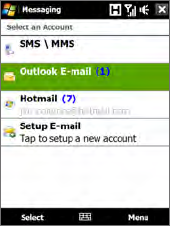
98 Exchanging Messages
6.1 Messaging
Messaging is a central location where you will find all types of messaging
accounts, which include text messages (SMS), multimedia messages (MMS),
and e-mail accounts.
To select a messaging account
Do one of the following:
• On the TouchFLO 3D Home screen, slide
to the Mail tab and then touch Menu
> Accounts > Accounts. The Account
Picker screen then opens where you can
select an account.
Tip You can also tap Start > Messaging.
to access the Account Picker screen.
• While you are in a message list of a
certain account, for example SMS \ MMS,
tap Menu > Go To to switch to other
types of messaging accounts. Account Picker screen
To configure message account settings
• Tap Menu > Options on the Account Picker screen; or
• Tap Menu > Tools > Options while you’re in a message list.
To automatically add a signature in outgoing messages
You can automatically add your name and other information as your
signature in outgoing SMS, MMS, and e-mail messages:
Note You need to specify your signature for each type of messaging account.
1. Tap Start > Messaging, then tap Menu > Options.
2. Tap Signatures.
3. Select a messaging account in which to add a signature.
4. Select the Use signature with this account check box.
5. In the provided text box, enter the information that will be displayed
as your signature.

Exchanging Messages 99
6. If you want the signature to be added whenever you reply or forward
messages, select the Use when replying and forwarding check box,
then tap OK.
7. Repeat the steps to add a signature to other messaging accounts.
6.2 Text Messages
Send short text messages (SMS) up to 160 characters long to other mobile
phones.
Create a new text message
Depending on your preference, there are a number of alternative ways you
can create a new text message.
From the TouchFLO 3D Home screen
1. On the Home screen, slide to the Messages tab.
2. Touch the New icon ( ) on the upper right side of the screen.
Tip To send a text message to a favourite contact, first select the photo of
the desired contact in the People tab to open his or her contact card and
then touch Send text message. For more information about working with
favourite contacts, see “People” in Chapter 3.
From the Account Picker screen
1. Tap Start > Messaging > SMS \ MMS.
2. Tap Menu > New > SMS.
From the Contacts screen
1. Tap Start > Contacts.
2. Tap the contact’s name to open his or her contact card.
3. Touch Send text message.
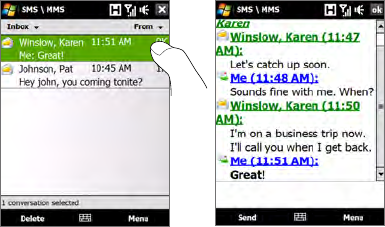
100 Exchanging Messages
Compose and send a text message
After creating a new text message, follow the steps below to enter your
message and then send it.
1. To add recipients,
enter their mobile phone numbers in the To field,
separating them with a semicolon. Y
ou can also tap To or tap Menu >
Add Recipient to add mobile phone numbers from Contacts..
2. Enter your message.
Tip To choose from preset messages, tap Menu > My Text and tap a desired
message. To check the spelling, tap Menu > Spell Check.
3. Tap Send.
Tips • For more information about entering text and symbols, see Chapter 4.
• If you want to know when a text message is received, before sending the
message that you are composing, tap Menu > Message Options, then
select the Request message delivery notification check box.
• To always receive a delivery notification, tap Menu > Tools > Options in
the text message list, tap SMS \ MMS, then select the Request delivery
notifications check box.
Manage text messages
Text messages that are sent to and received from a contact (or number)
are grouped as a single thread in your inbox. Threaded SMS lets you see
exchanged messages (similar to a chat program) with a contact on the
screen.

Exchanging Messages 101
To reply to a text message
1. In the SMS \ MMS inbox, tap a message thread to open it.
2. At the bottom of the screen, type your reply message and then tap
Send.
Enter your reply
message here
To copy a message in the thread to the SIM card
1. In the SMS \ MMS inbox, tap the message to open it.
2. Use the Navigation Up or Down control to select a message in the
thread that you want to copy to the SIM card.
Note You cannot copy a sent message from the thread to the SIM card.
3. Tap Menu > Copy to SIM.
To copy a text message from the SIM card to the device
1. In the SMS \ MMS inbox, select the SIM message you want to copy.
2. Tap Menu > Copy to Phone.
Note Copying SIM text messages to your device results in duplicate messages in
the Inbox folder when your SIM card is in use.
To delete a message in the thread
1. In the SMS \ MMS inbox, tap a message thread to open it.
2. Use the Navigation Up or Down control to select a message in the
thread that you want to delete.
3. Tap Menu > Delete.
To delete all messages in a thread
1. In the SMS \ MMS inbox, select a message thread using the Navigation
Up or Down control.
2. Tap Delete.
102 Exchanging Messages
To reply to a text message with an MMS message
You can reply to a text message in a thread or to a SIM text message using
an MMS message.
1. In the SMS \ MMS inbox, tap a message thread to open it.
2. Tap Menu > Insert, and then in the menu, select the item you want to
insert: Picture/Video, Audio or Attachment.
3. Tap Send.
Tips • You can also insert a vCard or vCalendar in your MMS message.
• To compose an MMS message complete with text, emoticons, media
and attachments, tap Menu > Advanced Composer. For instructions on
composing and sending an MMS message, see “MMS” in this chapter.
6.3 MMS
Sending multimedia messages (MMS) to your friends and family is fun
and easy. You can include pictures, videos, and audio clips in a multimedia
message.
Notes • Multimedia messaging is a charged service and has to be provisioned on
your mobile phone account. Contact your wireless service provider to
have MMS provisioned as part of your calling plan.
• Make sure the size of MMS messages that you send is within the limits
allowed by your wireless service provider.
Change MMS settings
Check your device to see if it is preconfigured with your wireless service
provider’s MMS settings. Add the MMS settings of your wireless service
provider if there are no preset MMS settings found on your device.
To configure MMS message settings
1. Tap Start > Messaging > SMS \ MMS.
2. Tap Menu > MMS Options. The Settings screen then appears.
3. In the Preferences tab, choose from the available options according
to your needs.
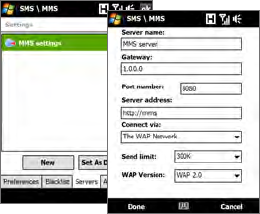
Exchanging Messages 103
4. Tap the Servers tab and
check if your device is
preset with MMS server
settings.
If there are no preset
settings, tap New and
enter the following
information, which you
obtained from your
wireless service provider:
• Gateway. Location of the MMS server, which is usually in the form
of an IP address.
• Port number. HTTP port number used for connecting to the MMS
server and for file transfer.
• Server address. URL address of the server where MMS messages
are stored.
• Connect via. Select the connection that your device uses for MMS
messages.
• Send limit. Select the maximum MMS message size allowed by
your wireless service provider.
• WAP version. Select either WAP 1.2 or WAP 2.0, depending on
which one is being used by your wireless service provider.
5. Tap Done.
Notes • If your device already has preset MMS settings, it is recommended that
you do not change these settings. If you change the preset settings, your
device may not be able to send and receive MMS messages.
• If you add several MMS message service providers to the Settings screen,
you can choose one as your default provider. Select the provider's name
in the list, then tap Set As Default.
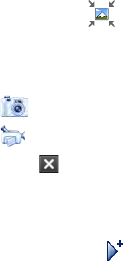
104 Exchanging Messages
Create and send MMS messages
You can compose MMS messages in a combination of slides, where each
slide can consist of a photo, video or audio clip, and/or text.
To compose an MMS message
1. Tap Start > Messaging > SMS \ MMS, then tap Menu > New > MMS.
2. When you see the Choose a MMS screen, tap a preset template, or tap
Custom to open a blank MMS message.
Note If you prefer to start composing from a blank MMS message every time,
select the Always choose custom check box.
3. In To, enter the recipient’s phone number or e-mail address directly,
or tap To, Cc, or Bcc to choose a phone number or an e-mail address
from Contacts.
Note You may need to scroll up to see Cc and Bcc.
4. Enter a subject for your message.
5. Tap the Insert icon ( )to select and insert a photo or video clip.
When selecting a photo or video clip, you can:
• Tap Select to insert the selected photo or video clip into the MMS
message you are composing.
• Tap to take a photo and insert it into the MMS message.
• Tap to record MMS video and insert it into the MMS message.
• Tap Exit ( ) to quit selection and return to the MMS message.
6. Enter text and insert audio clips by tapping the respective areas. See
“To add text to an MMS message” and “To add an audio clip to an
MMS message” for details.
7. To add more slides, tap or tap Menu > Slides > Insert Slide.
Repeat steps 5 and 6 to insert photos/videos, text, and audio onto
your slides.
8. Tap Send to send the MMS message.
Tip You can also send an MMS message from Pictures & Videos, Album, or the
Camera program.
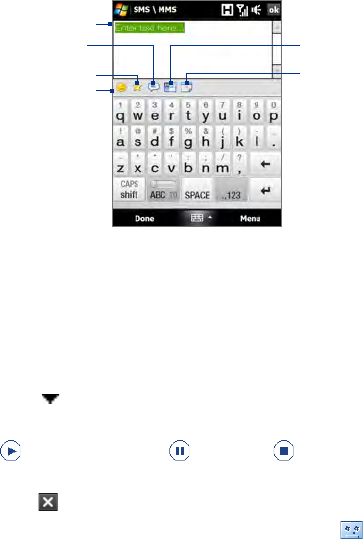
Exchanging Messages 105
To add text to an MMS message
When you tap Insert text here on your MMS message, an empty screen
appears where you can enter your text. You can insert the following types of
information:
Enter your own text
Choose from common words
or phrases from the My Text list
Include a Favourites link
Add an emoticon
Insert contact
information
Insert calendar
appointment
Tip To edit or delete a phrase on the My Text list, tap and hold a string, then tap
Edit or Delete from the shortcut menu. To add a new phrase, tap New.
To add an audio clip to an MMS message
You can add one audio clip per slide in your MMS message.
1. Tap Insert audio on your MMS message.
By default, My Documents will be shown. Tap My Music or another
folder that contains audio files. When navigating folders, tap the
down arrow ( ) to return to the upper folder.
2. Select an audio file. When selected, you can:
• Tap to play the audio clip, to pause, or to stop playback.
• Tap Select to insert it into your MMS message.
• Tap Exit ( ) to quit selection and return to your MMS message.
Note To record a new audio clip and add it to your MMS message, tap . The
Record pop-up window then opens. Tap Record to start recording, and Stop
to end the recording. Tap Play to listen to the recorded audio clip, then tap
Add. The new audio clip is then inserted into your MMS message.

106 Exchanging Messages
View and reply to MMS messages
To view an MMS message
• Use the playback controls , , and .
• Tap Contents to see a list of files included in the message. On the
Message Contents screen, you can do the following:
• To save a file, select it, and tap Menu > Save.
• To save the contents of a text file to the My Text list, tap Menu >
Save into My Text.
• To associate a photo to one of your contacts, tap Menu > Assign
to Contact.
To reply to an MMS message
1. In the SMS \ MMS inbox, press Navigation Up or Down to select the
mobile phone number or name of the contact who sent you the MMS
message.
2. In the threaded message, MMS messages will have the icon. Tap
this icon to open and view an MMS message.
3. After viewing the MMS message, tap Menu > via MMS to reply
with an MMS message or tap Menu > via SMS to reply with a text
message.
To block a phone number from sending you MMS messages
If you do not want to receive MMS messages from a particular sender, you
can add the sender’s phone number to the MMS Blacklist.
1. When you receive a new MMS message, open and view the message.
2. To avoid receiving MMS messages from this sender next time, tap
Menu > Show > Message Detail.
3. On the Message Detail screen, tap Menu > Show Contact Details.
4. Tap Menu > Save to Blacklist.
5. Tap Done.
Tip To unblock a phone number and allow the sender to send you MMS
messages, remove the number from the Blacklist. Go to the SMS \ MMS
inbox, tap Menu > MMS Options > Blacklist tab, tap and hold the phone
number in the Blacklist, and then tap Delete.
Exchanging Messages 107
6.4 Types of E-mail Accounts
You can set up the following types of e-mail accounts on your device:
• Outlook e-mail that you sync with your computer or the Exchange
Server.
• E-mail account that you have from an Internet Service Provider (ISP)
or other e-mail provider.
• Web-based e-mail accounts such as Gmail®, Yahoo!® Mail Plus, AOL®,
and others.
• Work account that you access using a VPN connection.
Set up your device to synchronize Outlook e-mail with
the computer
If you have installed the synchronization software on your computer and
created a partnership with your device, then your device is ready to send
and receive Outlook e-mail.
If you have not yet installed the synchronization software nor created a
partnership, do so by following the procedures in Chapter 5.
Tip To set up your company e-mail account so that you can access Outlook
e-mail messages wirelessly, you must set up your device to synchronize via
an over-the-air connection with your company’s Exchange Server. For more
information about synchronizing with your company e-mail server, see
Chapter 7.
Add an e-mail account
To add a new e-mail account, you can do one of the following:
On the TouchFLO 3D Home screen, slide to the Mail tab and then
touch Menu > Accounts > New Account; or
Tap Start > Messaging > Setup E-mail.
The E-mail Setup wizard then opens and lets you enter your e-mail account
settings. See “E-mail Setup Wizard” in this chapter for details.
•
•
108 Exchanging Messages
6.5 E-mail Setup Wizard
Windows Mobile’s E-mail Setup wizard walks you through the process
of setting up your e-mail account. It has an Auto Setup feature which can
automatically set up your e-mail account based on the e-mail address and
password that you enter, if your e-mail provider settings are preconfigured
on your device. If the settings are not found on your device, Auto Setup
then attempts to retrieve the settings online for which you may be charged
when your device connects to the Internet and downloads them. If it
cannot find the e-mail settings online, you need to enter them manually.
Note For more information about setting up your company Outlook e-mail
account, see Chapter 7.
Set up an Internet e-mail account
Set up a POP3 or IMAP4 e-mail account on your device if you have an
e-mail account from an Internet service provider (ISP) or other e-mail
service provider, or a web-based account such as Gmail, Yahoo! Mail Plus,
or AOL. You can also add a work account that you access using a VPN server
connection as a POP3/IMAP4 account.
1. Add a new e-mail account. See “Add an e-mail account” for
instructions.
2. Enter your E-mail address and the Password for your e-mail account
and select the Save password option. Tap Next.
3. If e-mail provider settings are found preconfigured on your device,
the E-mail Setup wizard shows a successful message. Tap Next.
If the settings are not found on your device, select the Try to get e-
mail settings automatically from the Internet checkbox to find and
download e-mail server settings from the Internet and then tap Next.
4. Enter Your name and the Account display name and then tap Next.
Note If the E-mail Setup wizard was unsuccessful in finding and downloading
settings from the Internet, select Internet e-mail from the Your e-mail
provider list on the next screen. You will be asked to enter e-mail server
settings. See “To specify e-mail server settings” for details.

Exchanging Messages 109
5. In the Automatic Send/Receive list, choose how frequent you want
e-mail messages to be automatically sent and downloaded on your
device.
Note Tap Review all download settings to select download options, set the
e-mail format as HTML or plain text, and more. For more information,
see “To customize download and format settings."
6. Tap Finish.
To specify e-mail server settings
If Auto Setup is unsuccessful, contact your ISP or e-mail provider for the
Incoming mail server and Outgoing mail server settings so you can enter
them on your device.
Other options that you can select include the following:
• Select the Outgoing server requires authentication check box, if
required by your provider.
• If the outgoing e-mail server requires a different user name and
password for sending e-mail, clear the Use the same user name and
password for sending e-mail check box. You will be prompted to
enter this information.
• Tap Advanced Server Settings, then select the Require SSL check
boxes if your e-mail provider uses an SSL connection for more secured
e-mail. From the Network connection list, select the data connection
that you use for connecting to the Internet.
To customize download and format settings
Before you tap Finish when setting up your POP3 or IMAP4 e-mail account,
you can tap the Review all download settings link at the bottom of the
screen to choose download options, message format, and other settings.
Options Description
Automatic Send/Receive You can select a time interval for connecting to
the Internet automatically to send and receive
messages.
Download messages Set the number of days of messages that you
want to be downloaded to your device.
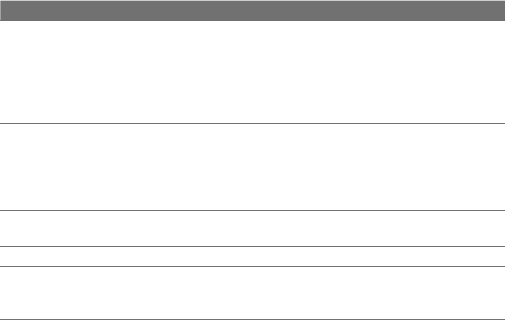
110 Exchanging Messages
Options Description
Send/receive when I click
Send
By default, messages are immediately delivered
when you tap Send. If you prefer to save
outgoing messages to the Outbox folder first,
clear the check box. (In this case, you will need
to manually send messages by tapping Menu >
Send/Receive).
Use automatic send/
receive schedule when
roaming
This allows your device to data roam when
there is a set time interval for connecting to the
Internet automatically. Since this may result in
higher connection costs, you may want to leave
the check box cleared.
When deleting messages Choose whether to delete messages from the
mail server when you delete them on your device.
Message format Select HTML or Plain Text.
Message download limit Select the e-mail download size. If you have large
volumes of e-mail, use a lower size or select to
download headers only.
Set up a custom domain e-mail
When you are using an e-mail domain name that is hosted by a different e-
mail provider (for example, your e-mail address may be Benjamin@startup.
com but Email.com hosts the e-mail account and provides e-mail services),
select the Custom Domain option in the E-mail Setup wizard to set up your
e-mail account on your device.
1. Add a new e-mail account. See “Add an e-mail account” for
instructions.
2. Enter your E-mail address and the Password for your e-mail account
and select the Save password option. Tap Next.
3. Clear the Try to get e-mail settings automatically from the
Internet and then tap Next.
4. In Your e-mail provider, select Custom domain and then tap Next.
5. Enter the domain of your e-mail provider and then tap Next.
6. The E-mail Setup wizard then tries to find the e-mail provider settings
on your device or from the Internet. If the settings are found, it shows
a successful message. Tap Next.

Exchanging Messages 111
7. Enter Your name and the Account display name and then tap Next.
Note If the E-mail Setup wizard was unsuccessful in finding the settings, you
will be prompted to enter e-mail server settings on the succeeding
screens. See “To specify e-mail server settings” for details.
8. In the Automatic Send/Receive list, choose how frequent you want
e-mail messages to be automatically sent and downloaded on your
device.
Note Tap Review all download settings to select download options, set the
e-mail format as HTML or plain text, and more. For more information,
see “To customize download and format settings."
9. Tap Finish.
6.6 Using E-mail
After setting up e-mail accounts on your device, you can start sending and
receiving e-mail messages.
Create a new e-mail message
Depending on your preference, there are two ways you can create a new
e-mail message.
To start from an empty message
1. On the TouchFLO 3D Home screen, slide to the Mail tab.
2. Select the e-mail account you want to use on the right side of the
screen.
Tip To choose from other e-mail accounts that are not displayed on the
Mail tab, touch Menu > Accounts > Accounts and then select an e-mail
account from the Account Picker screen.
3. Touch the New Mail icon ( ) to create a new e-mail.
To send an e-mail to a favourite contact
1. On the TouchFLO 3D Home screen, slide to the People tab.
2. Swipe your finger on the screen to flip through the photos of your
favourite contacts.
3. When the photo of the desired contact is displayed, touch the
displayed photo and then touch Send e-mail.
112 Exchanging Messages
For more information about working with favourite contacts, see “People” in
Chapter 3.
Tip You can also touch Start > Contacts, select a contact name, and then touch
Send e-mail.
Compose and send an e-mail
After creating a new e-mail, follow the steps below to enter your message
and then send it.
1. To add recipients, enter their e-mail addresses, separating them with
a semicolon. You can also tap To if you want to add e-mail addresses
stored in Contacts.
2. Enter a subject and compose your message.
Tip To choose from preset messages, tap Menu > My Text and tap a desired
message. To check the spelling, tap Menu > Spell Check.
3. Tap Send.
Tips • For more information about entering text and symbols, see Chapter 4.
• To set the message priority, tap Menu > Message Options.
• If you are working offline, e-mail messages are moved to the Outbox
folder and will be sent the next time you connect.
To add an attachment to a message
1. In the message that you are composing, tap Menu > Insert and tap
the item you want to attach: Picture, Voice Note, or File.
2. Select the file or picture you want to attach, or record a voice note.
Filter the Inbox message list
When the Inbox on your device is full of messages, you can filter your Inbox
to display only the messages that contain a particular sender or subject you
are searching for.
To filter your Inbox
Enter the sender name or e-mail subject you want to look for. As you type
characters, the message list narrows down to the sequence of characters
you have entered.
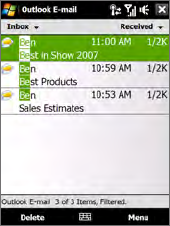
Exchanging Messages 113
For example, entering “B”, then “E” narrows
the list to only the e-mails that contain
sender names and e-mail subjects that start
with “BE.”
View and reply to messages
To download a complete e-mail
By default, each e-mail received in the inbox on your device contains only
the first few kilobytes of the message. When you open an e-mail, it displays
only the headers and part of the message. You must download the whole
e-mail to view the complete content.
To download a complete e-mail message, open the e-mail and then do one
of the following:
• Finger-scroll to the end of the message, and tap Get entire message
and any attachments (POP3 e-mail account) or tap Get the rest of
this message (IMAP4 and Outlook e-mail accounts).
• Tap Menu > Download Message.
Notes • The Fetch Mail feature, which is available for POP3 and IMAP4 Internet
e-mail accounts, downloads an entire e-mail without the need for you to
perform a full synchronization. This limits the download to just the e-mail
message that you want and helps save data cost.
Fetch Mail is also available for Outlook E-mail. See “Instant download
through Fetch Mail” in Chapter 7 for details.
• Download may take some time, depending on the speed of your Internet
connection, size of the whole e-mail, and whether file attachments are
automatically downloaded.
114 Exchanging Messages
To download file attachments
POP3 e-mail account:
File attachments of a POP3 Internet e-mail account are automatically
downloaded when you download a complete e-mail.
IMAP4 and Outlook e-mail accounts:
File attachments appear below the subject of an e-mail message.
Tapping an attachment opens the attachment if it has been fully
downloaded or marks it for download the next time you send and
receive e-mail.
You can set automatic download of file attachments. See “Customize
e-mail settings” in this chapter for details.
To reply to or forward a message
1. Open the message and tap Menu > Reply, Menu > Reply All, or
Menu > Forward.
2. Enter your response, then tap Send.
Notes • You can receive and view HTML e-mails from any type of e-mail account.
The HTML format is retained, without layout shifting or resizing.
HTML e-mail support in Outlook Mobile is available only if you are
synchronizing your device with Microsoft Exchange Server 2007.
• When replying using an Outlook e-mail account, you can customize
ActiveSync to exclude addresses, including your own, from being added
to the recipient list. Tap Menu > Options in ActiveSync, select the E-mail
item, tap Settings, then tap Advanced. In the My e-mail addresses text
box, enter e-mail addresses you want to exclude.
Synchronize e-mails
Synchronizing e-mails ensures that new e-mails are downloaded to the
device Inbox folder, e-mails in the Outbox folder are sent, and e-mails
deleted from the server are removed from your device. The manner in which
you synchronize e-mails depends on the type of e-mail account you have.
To automatically synchronize an Outlook e-mail account
1. Connect your device to your computer through USB or Bluetooth.
Otherwise, connect through Wi-Fi or a data connection if you are
synchronizing Outlook e-mail with the Exchange Server. For more
information, see Chapter 7.
•
•
Exchanging Messages 115
2. Synchronization automatically begins, and your device sends and
receives Outlook e-mail.
To manually synchronize your Outlook or Internet e-mail account
1. Select your Internet e-mail account. (See “To select a messaging
account” in this chapter.)
2. Tap Menu > Send/Receive.
Customize e-mail settings
To change the download size and format for Outlook e-mail
1. Disconnect your device from the computer.
2. Tap Start > Programs > ActiveSync.
3. Tap Menu > Options, select E-mail, then tap Settings.
4. On the E-mail Sync Options screen:
• Under Message format, select HTML or Plain text.
• Under Download size limit, select the desired e-mail size.
5. Close ActiveSync and reconnect your device to the computer.
To change the download size and format for Internet e-mail
1. Tap Menu > Options on the Account Picker screen, or tap Menu >
Tools > Options while you’re in a message list.
2. Tap your POP3 or IMAP4 Internet e-mail account.
3. Tap Download Size Settings.
4. Under Message format, select HTML or Plain text.
5. Under Download size limit, select the desired e-mail size.
6. Tap Done.

116 Exchanging Messages
To automatically receive attachments on Outlook e-mails
1. Tap Start > Programs > ActiveSync.
2. Tap Menu > Options.
3. Tap E-mail > Settings, then select Include file attachments.
To automatically receive attachments on IMAP4 e-mails
1. Tap Menu > Options on the Account Picker screen, or tap Menu >
Tools > Options while you’re in a message list.
2. Tap the name of your IMAP4 e-mail account.
3. Tap Download Size Settings.
4. In Download attachments:
Select All attachments to always download file attachments; or
Select a file size limit for auto-downloading attachments.
5. Tap Done.
To store attachments on the internal storage
1. Tap Start > Messaging.
2. Tap Menu > Options > Storage tab.
3. Select the When available, use this storage card to store
attachments check box.
•
•
118 Working With Company E-mails and Meeting Appointments
7.1 Synchronizing with the Exchange Server
To keep up-to-date with your company e-mails and meeting schedules
while you’re out of the office, you can connect your device to the Internet
through Wi-Fi or a data connection and synchronize with your company’s
Exchange Server.
Set up an Exchange Server connection
Before you can synchronize or access information on the Exchange Server,
you need to set up an Exchange Server connection on your device. You
need to get the following information from your network administrator and
enter them on your device:
• Exchange Server name (must be Outlook Web Access server name)
• Domain name
• User name and password that you use at work
If you have not synchronized your device with your computer, follow these
steps to set up an Exchange Server connection.
1. Add a new e-mail account. See “Add an e-mail account” in Chapter 6
for instructions.
2. Enter the E-mail address and Password for the e-mail account and
select the Save password option. Tap Next.
3. Clear the Try to get e-mail settings automatically from the
Internet option and tap Next.
4. In Your e-mail provider, select Exchange server and tap Next.
5. Tap Next again.
6. Select the Attempt to detect Exchange Server Settings
automatically option and tap Next.
7. Enter the Domain name and tap Next.
8. In Server address, enter the Exchange Server address and tap Next.
9. Select the items that you want to sync with the Exchange Server.
Working With Company E-mails and Meeting Appointments 119
Tips • To change synchronization settings of an information item, for
example, E-mail, select the item, then tap Settings.
• To change the rules for resolving synchronization conflicts, tap Menu
> Advanced.
10. Tap Finish.
Notes • If you synchronized e-mails with your computer before, open ActiveSync
on your device, then tap Menu > Add Server Source to set up an
Exchange Server connection. When prompted to select information types
for synchronization, you must first clear the E-mail check box under the
Windows PC item before you can select E-mail under Exchange Server.
• To change Exchange Server settings, open ActiveSync on your device,
then tap Menu > Configure Server.
Start synchronization
Before you start synchronizing with the Exchange Server, make sure your
device has been set up with a Wi-Fi or data connection to the Internet
so that you can synchronize over the air. For more information about
connections, see Chapter 8.
After you finish setting up an Exchange Server connection, your device
automatically starts synchronization.
To manually start synchronization, you can do one of the following:
On the TouchFLO 3D Home screen, slide to the Settings tab and then
touch Sync Data; or
Tap Start > Programs > ActiveSync and then tap Sync.
Note If you connect your device to your office computer via a USB or Bluetooth
connection, you can use this connection to the computer to “pass through”
to the network and download Outlook e-mails and other information to your
device.
•
•
120 Working With Company E-mails and Meeting Appointments
7.2 Working With Company E-mails
Your device gives you instant access to your company e-mails and lets
you manage your messages easier. Direct Push, Fetch Mail, Remote e-mail
search, and e-mail flags are just some of the tools you can use to manage
your e-mails.
Note Some messaging features depend on the Microsoft Exchange Server version
used in your company. Check with your network administrator for the
availability of these features.
Automatic synchronization through Direct Push
Direct Push technology (push e-mail feature) enables you to receive new
e-mails on your device as soon as they arrive in your Inbox on the Exchange
Server. Items such as contacts, calendar and tasks are also immediately
updated onto your device when these items have been changed or new
entries have been added on the Exchange Server. To make Direct Push work,
you need to have a Wi-Fi or data connection on your device.
You need to perform a full synchronization between your device and the
Exchange Server first before Direct Push can be enabled.
Requirement The Direct Push feature works for your device only if your company
is using Microsoft Exchange Server 2003 Service Pack 2 (SP2)
with Exchange ActiveSync or higher version.
You can turn on Direct Push in the Comm Manager or ActiveSync.
To turn on Direct Push in Comm Manager
1. To open the Comm Manager, slide to the Settings tab on the
TouchFLO 3D Home screen and then touch Communications.
Tip You can also tap Start > Programs > Comm Manager.
2. On the Comm Manager screen, touch Microsoft Direct Push.
To turn on Direct Push in ActiveSync
1. Tap Start > Programs > ActiveSync and then tap Menu > Schedule.
2. Select As items arrive in the Peak times and Off-peak times boxes.
Note When Direct Push is off, you need to manually retrieve your e-mails.
Working With Company E-mails and Meeting Appointments 121
Scheduled synchronization
If you do not want to use Direct Push, you can set a regular schedule for
synchronizing Outlook e-mail and information.
1. In ActiveSync on your device, tap Menu > Schedule.
2. Select a shorter time interval in the Peak times box for you to be able
to receive e-mails more frequently. (Peak times usually refer to your
working hours when e-mail volume is high).
3. Select a longer interval in the Off-peak times box.
Tip To set the days and hours that make up your peak and off-peak times,
tap the peak times link at the bottom of the screen.
Instant download through Fetch Mail
The Fetch Mail feature downloads an entire e-mail immediately without the
need for you to perform a full Send/Receive action. This limits the download
to just the e-mail message that you want and helps save data cost.
Requirement Fetch Mail works for your device only if your company is using
Microsoft Exchange Server 2007 or higher.
1. On the TouchFLO 3D Home screen, slide to the Mail tab, select your
Outlook account, and then tap Inbox.
Tip You can also tap Start > Messaging > Outlook E-mail.
2. Open an e-mail message.
3. By default, only the first few words of the message is shown. To
download the whole e-mail, finger-scroll to the end of the message,
then tap Get the rest of this message.
4. Wait for the remainder of the message body to download.
Notes • For information about changing e-mail sync options such as setting the
download size for e-mail, see "Customize e-mail settings" in Chapter 6.
• When you receive an e-mail that contains a link to a document such as a
PDF or Microsoft Office document located on SharePoint or an internal
file server, you can tap the link to view the document on your device. You
can view the document only if you have a Microsoft Outlook account that
synchronizes with Microsoft Exchange Server 2007 or later. Exchange
Server must also be set up to allow access to SharePoint document
libraries or internal file servers.
122 Working With Company E-mails and Meeting Appointments
Search for e-mails on the Exchange Server
You can access e-mails that are not available on your device by searching
your Microsoft Exchange Server mailbox. The search results are downloaded
and displayed in a Search Results folder.
Requirement Your company must be using Microsoft Exchange Server 2007 or
higher.
1. Tap Start > Messaging > Outlook E-mail.
2. Tap Menu > Tools > Search Server.
3. In the Look for text box, enter the search keyword.
4. Choose the date range of messages to search from.
5. In the Look in list, specify whether to search in the Inbox, Sent Items,
or All Folders.
6. Tap Search.
Tip To clear the search results and return to the message list, tap Menu > Clear
Results.
Flag your messages
Flags serve as a reminder for you to follow-up on important issues or
requests contained in e-mail messages. Flagging messages, which has been
a useful feature on desktop Outlook E-mail, can also be done in Outlook
Mobile on your device. You can flag received e-mail messages on your
device.
Requirement Flags are enabled only if e-mails are synchronized with Microsoft
Exchange Server 2007 or higher. Flags are disabled or hidden
if e-mails are synchronized with earlier versions of Microsoft
Exchange Server.
To flag or unflag a message
1. Open Outlook on your device and access the Inbox.
2. Select a message or open a message.
3. Tap Menu > Follow Up and select one of the following options:
• Set Flag Mark the message with a red flag to indicate that it needs
follow up.
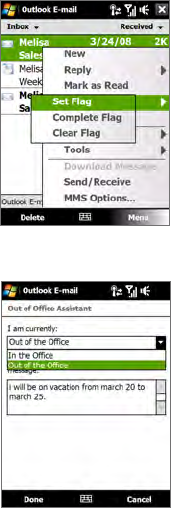
Working With Company E-mails and Meeting Appointments 123
• Complete Flag Mark the message
with a check mark to indicate that
the issue or request in the e-mail is
already completed.
• Clear Flag Remove the flag to
unmark the message.
Note E-mail message reminders are displayed
on your device if the messages are
flagged with reminders and synchronized
from the Exchange Server.
Out-of-office auto-reply
Outlook Mobile allows you to retrieve and
change your out-of-office status. Just like
desktop Outlook E-mail, Outlook Mobile
automatically sends an auto-reply message
when you’re not available.
To send out-of-office auto-reply messages
1. Tap Start > Messaging > Outlook
E-mail.
2. Tap Menu > Tools > Out of Office.
3. In the I am currently list, select Out of
the Office.
4. Enter your auto-reply message, then
tap Done.
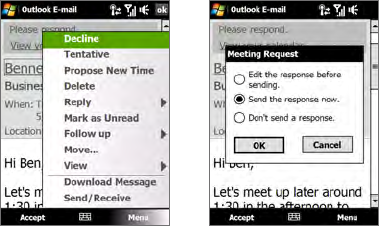
124 Working With Company E-mails and Meeting Appointments
7.3 Managing Meeting Requests
When you schedule and send meeting requests from your device, you can
invite attendees to your meeting and check their status to know about their
availability.
When you receive a meeting request, you can reply by accepting or
declining the request. The meeting request also clearly indicates whether or
not there are conflicting or adjacent meetings.
Requirement Your company must be using Microsoft Exchange Server 2007 or
higher.
To reply to a meeting request
1. When you receive a meeting request e-mail, a notification will be
displayed on your device. Open the e-mail.
2. Tap Accept to reply and accept the meeting request, or tap Menu >
Decline if you cannot attend the meeting.
Tips • Before responding, you can check your availability during the time
of the requested meeting by tapping View your calendar.
• If the time of the meeting conflicts with your other appointments,
a “Scheduling Conflict” status appears on top of the e-mail.
3. Choose whether or not to edit your response e-mail before sending,
then tap OK.
If you accepted the meeting request, it will automatically be added as
an appointment in Calendar on your device.
Working With Company E-mails and Meeting Appointments 125
To view the list of meeting participants
1. Tap Start > Calendar.
2. Tap a meeting request that you sent and then tap Attendees. The
required and optional attendees will be listed.
Icons indicating whether each attendee has accepted or declined the
meeting request will also be displayed.
Note To see the icon indicators in the attendees list, make sure Calendar is
synchronized with the Exchange Server.
Tips • For information about creating a meeting request, see “To send a meeting
request” in Chapter 12.
• To view an attendee’s contact information, tap the attendee’s name. If
the attendee is included in your contacts list, you will see the contact
information immediately. If the attendee is not in your contacts list, tap
Company Directory to view the contact information.
7.4 Finding Contacts in the Company Directory
In addition to having contacts on your device, you can access contact
information from your organization’s Company Directory. By having
over-the-air access to the Company Directory, you can easily send e-mail
messages and meeting requests to anyone in your company.
Requirement Access to the Company Directory is available only if your
organization is running Microsoft Exchange Server 2003 SP2 or
higher, and you have completed your first synchronization with
the Exchange Server.
1. Synchronize with the Exchange Server.
2. Do any of the following:
• In Contacts, tap Menu > Company Directory.
• In a new e-mail message, tap the To box (or tap Menu > Add
Recipient), then tap Company Directory on the top of the list.
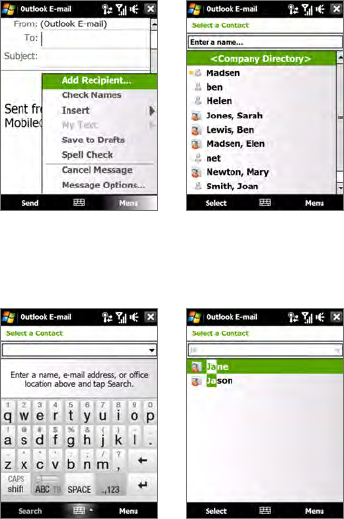
126 Working With Company E-mails and Meeting Appointments
• When creating a meeting request and selecting required and
optional attendees in Calendar, tap Company Directory.
3. Enter a partial or full contact name and tap Search. In the search
results list, tap a contact to select it.
Notes • You can save a contact from the Company Directory to your device by
selecting the contact, then tapping Menu > Save to Contacts.
• You can search on the following information as long as that information is
included in the Company Directory: First name, Last name, E-mail name,
Display name, E-mail address, or Office location.
128 Internet
8.1 Ways of Connecting to the Internet
Your device’s networking capabilities allow you to access the Internet or
your corporate network at work through one of the following connections:
• Wi-Fi
• GPRS, 3G or EDGE
• Dial-up
Note You can also add and set up the following connections:
• VPN: A VPN connection is used to access your corporate network by using
an existing Internet connection.
• Proxy: A Proxy connection is used to access the Internet using an existing
connection to your corporate or WAP network.
Wi-Fi
Wi-Fi provides wireless Internet access over distances of up to 300 feet (100
meters).
To use Wi-Fi on your device, you need access to a wireless access point or
“hotspot”.
Note The availability and range of your device’s Wi-Fi signal depends on the
number, infrastructure, and other objects through which the signal passes.
To turn Wi-Fi on and off
1. On the Home screen, slide to the Settings tab.
2. On the Settings screen, tap Communications > Wi-Fi to enable/
disable the wireless function.
When enabled, the On indicator is activated and available wireless
networks will be detected.
To connect to a wireless network
After Wi-Fi is turned on, your device scans for available wireless networks in
your area.
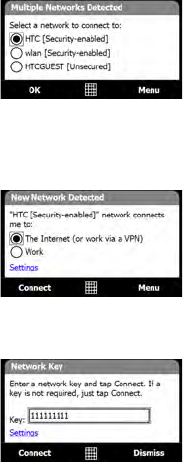
Internet 129
1. The network names of the detected
wireless networks are displayed on
a pop-up message window. Tap the
desired wireless network, then tap
OK.
Note When you select an open (unsecured)
network, you will be automatically
connected to the network after
tapping OK. You do not need to do
steps 2 and 3.
2. On the next pop-up message window,
do one of the following:
• Tap The Internet if the wireless
network connects your device to
the Internet.
• Tap Work if the wireless network
connects your device to a private
network.
3. Enter the key and then tap Connect.
Next time you use your device to detect wireless networks, you will not see
the pop-up message windows again, and you will not be prompted to enter
the network key of the previously accessed wireless network (unless you
perform a hard reset which will erase custom settings on your device).
Note Wi-Fi networks are self-discoverable, which means no additional steps are
required for your device to connect to a Wi-Fi network. It may be necessary
to provide a username and password for certain closed wireless networks.

130 Internet
To check wireless network status
You can check the current wireless connection status from any of the
following screens of your device:
• Title bar.
When you enable Wi-Fi on your device, the Wi-Fi ON icon appears
on the title bar.
After Wi-Fi is turned on, your device scans for available wireless
networks and the wireless signal icon appears on the title bar. The
arrows in this icon move back and forth while your device is scanning
for a wireless network signal. Once your device successfully connects
to a wireless network, the arrows stop moving.
• Wireless LAN screen.
On the Home screen, slide to the
Settings tab and then tap Menu >
Wireless Networks. On the Main tab,
you will see the wireless network that
your device is currently connected to.
The configuration and signal quality of
the wireless network are also shown.
• Configure Wireless Networks screen.
On the Home screen, slide to the
Settings tab and then tap All Settings.
In the Connections tab, tap Wi-Fi. This
screen displays the wireless networks
currently available.
To connect to a wireless network in the
list, tap and hold on the desired network,
then tap Connect. Tap a wireless
network in the list to view or change its
connection settings.
You can also add new wireless networks,
if available, by tapping Add New.
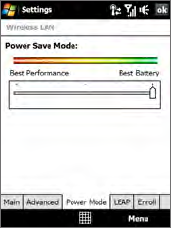
Internet 131
To save battery power while connected to a wireless network
Using Wi-Fi quickly consumes battery power. Turn off Wi-Fi when not in use.
You can also enable power saving settings.
1. On the Home screen, slide to the
Settings tab.
2. On the Settings screen, tap Menu >
Wireless Networks > Power Mode
tab.
3. On the Power Mode tab, move the
Power Save Mode slider to a position
that optimizes performance with the
least power consumption.
For example, move the slider to
the left (Best Performance) to
have the optimal wireless network
performance; move to the right (Best
Battery) to obtain the maximum
battery usage.
GPRS/3G
Use GPRS/3G (or EDGE, if available) to connect to the Internet and to send
and receive e-mail and picture messages on your device. You will need a
data plan to use your wireless service provider’s GPRS/3G network. Check
with your wireless service provider to find out about GPRS/3G rates.
GPRS/3G settings are already preconfigured on your device, and your device
is ready to use your wireless service provider’s GPRS/3G services. Do not
change the settings as this may cause services to stop working.
To add a new GPRS/3G connection
When you need to add another GPRS/3G connection on your device, obtain
the Access point name from your wireless service provider. Also, check if
the GPRS/3G network requires a user name and password.
1. On the Home screen, slide to the Settings tab and then tap All
Settings.
2. On the Connections tab, tap Connections.
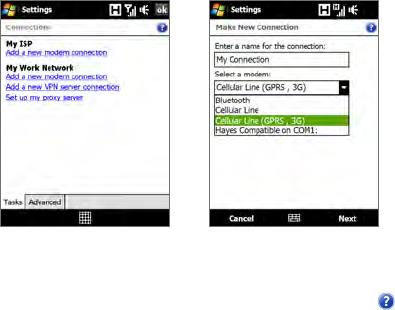
132 Internet
3. In My ISP, tap Add a new modem connection.
4. On the Make New Connection screen, enter a name for the
connection.
5. In the Select a modem list, select Cellular Line (GPRS , 3G), then tap
Next.
6. Enter the Access point name, then tap Next.
7. Enter the user name and password, if required, then tap Finish.
Notes • To view help information for any screen, tap the help icon ( ).
• To modify your connection settings, tap Manage existing connections
on the Connections screen, and complete the connection wizard.
Dial-up
To set up a dial-up connection to your Internet Service Provider (ISP) on
your device, you need the same settings that you normally use when you
dial up from your computer. This includes the ISP server phone number,
your user name and password.
1. On the Home screen, slide to the Settings tab and then tap All
Settings.
2. On the Connections tab, tap Connections.
3. In My ISP, tap Add a new modem connection.
4. In the Select a modem list, select Cellular Line, then tap Next.




